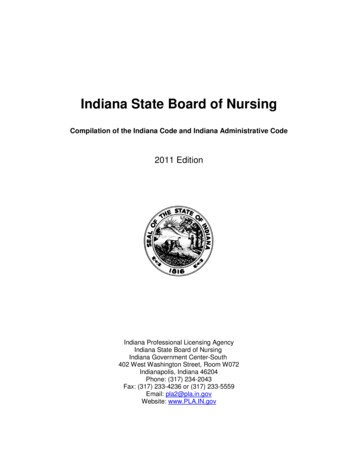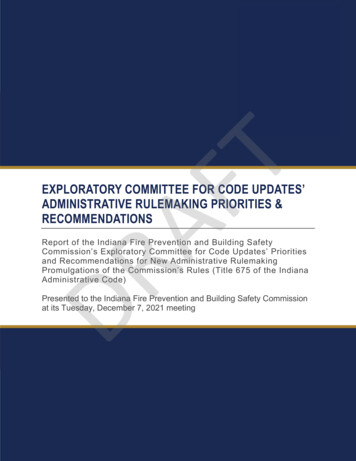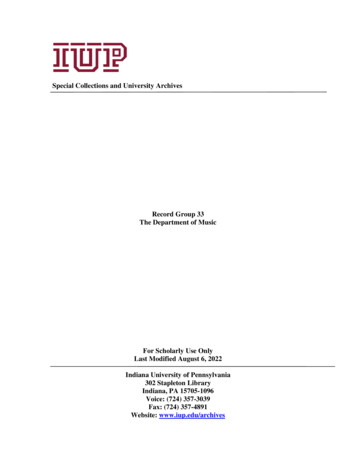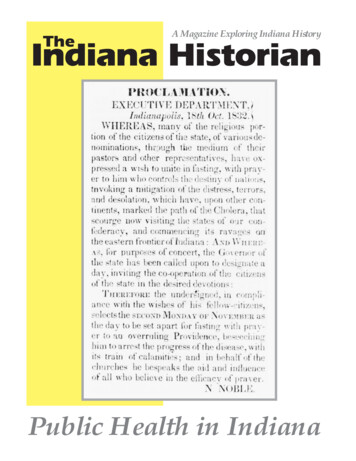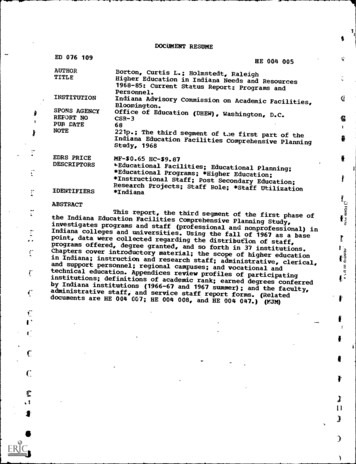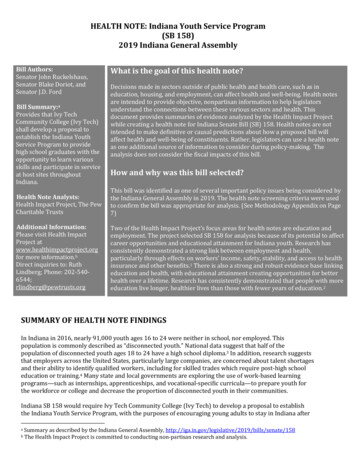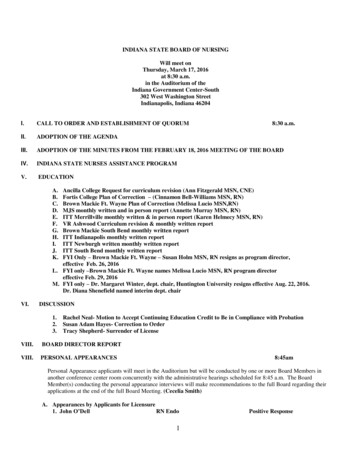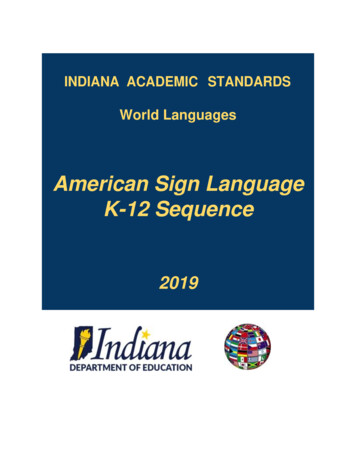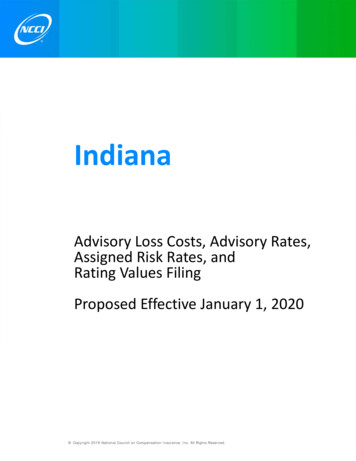
Transcription
IndianaAdvisory Loss Costs, Advisory Rates,Assigned Risk Rates, andRating Values FilingProposed Effective January 1, 2020 Copyright 2019 National Council on Compensation Insurance, Inc. All Rights Reserved.
September 24, 2019Steve RobertsonCommissioner of InsuranceIndiana Department of Insurance311 W. Washington St., Suite 300Indianapolis, IN 46204-2787RE:Workers Compensation Advisory Loss Costs, Rates, and Rating Values:Indiana Voluntary and Assigned Risk MarketsDear Commissioner Robertson:In accordance with the applicable statutes and regulations in the state of Indiana, I am filing for yourconsideration and approval the workers compensation advisory loss costs, advisory rates, and ratingvalues for the Indiana voluntary market and assigned risk rates and rating values for the Indianaassigned risk market.This filing proposes a 6.9% decrease to the overall voluntary loss cost level and a 6.7% decrease tothe overall voluntary and assigned risk rate level to become effective on January 1, 2020 for new andrenewal business.Included with this filing is a proposed increase to the assigned risk surcharge from 25% to 30%. Inconjunction with this change, an increase to the premium threshold (i.e., from 2,500 to 2,750) forwhich the assigned risk surcharge would be applicable is also being proposed. For several years,actuarial indications have suggested a need for additional premium from assigned risk policies (seeAppendix D of the proposed filing). However, despite this indicated premium need for the pastseveral years, a change to the surcharge has not been proposed in recognition of the negativeimplications such a change would have on employers in the assigned risk market. The additionalrate need continues to grow, and now is projected at more than 11% (i.e., for the assigned riskmarket to be self-funded). By increasing the surcharge in tandem with the proposed 6.7% ratedecrease, the overall premium impact to risks in the assigned risk market would be lessened.1Please note the following in connection with this filing:1. As a result of Item B-1397, effective July 1, 2007, a single combined rate is still calculatedfor Class Codes 7710 and 7711 via a payroll-weighted average of the separately indicatedrates for these two class codes.2. As a result of Item B-1435, effective January 1, 2018:a. Class Codes 4053, 4061, and 4062 are combined to reflect the final year of a three-yeartransition program, and Class Codes 4053 and 4061 are discontinued.b. Class Codes 4683 and 4716 are combined to reflect the final year of a three-yeartransition program, and Class Code 4716 is discontinued.3. As a result of Item B-1436, effective January 1, 2019:1Based on NCCI data for 2018, approximately 2,500 policies would be subject to the increased surcharge. However,due to the increase in premium eligibility from 2,500 to 2,750, approximately 220 risks in the assigned risk marketwould no longer be subject to an assigned risk surcharge.
a. Class Codes 8825 and 8826 are combined to reflect the final year of a two-yeartransition program, and Class Code 8825 is discontinued.b. Class Code 8829 is discontinued and the rate for Class Code 8824 is payroll-weighted toreflect the combined experience of Class Codes 8824 and 8829.4. As a result of Item B-1437, effective January 1, 2020:a. Class Codes 2286 and 2220 are combined to reflect the first year of a two-year transitionprogram. In the second year of the transition, Class Code 2286 will be discontinued.b. Class Codes 2670 and 2688 are combined to reflect the first year of a two-year transitionprogram. In the second year of the transition, Class Code 2670 will be discontinued.c. Class Code 4360 is discontinued and the rate for Class Code 7610 is payroll-weighted toreflect the combined experience of Class Codes 4360 and 7610.d. Class Code 5508 is discontinued and the rate for Class Code 5507 is payroll-weighted toreflect the combined experience of Class Codes 5508 and 5507.e. Class Code 4670 is discontinued.5. As a result of Item R-1417, the retrospective rating plan parameters were updated.6. As a result of Item 01-IN-2017, effective January 1, 2018, class code 7732 is establishedand has a rate of 122.00 and a loss cost of 89.00 per volunteer. This rate and loss costwill remain in effect until, at least, the 1/1/2021 filing.Our desire is to make this filing as clear as possible. For additional information, we would be glad tomeet with you at your convenience.We make this filing on behalf of the members and subscribers of the Indiana Compensation RatingBureau. All persons on the “Interested Persons List” have been notified of the captioned filing.We respectfully request that the filing be “Filed” electronically via the NAIC SERFF system withinthirty days.Sincerely,Actuarial content prepared by:Karen H. Byrd, AICPresident & CEORobert Moss, ACAS, MAAAAssistant Actuary, NCCIEnclosure
Copyright 2019 National Council on Compensation Insurance, Inc. All Rights Reserved.These materials are comprised of NCCI actuarial judgment and proprietary and confidentialinformation which are valuable assets of NCCI and are protected by copyright and otherintellectual property laws. Any persons in the legal possession of these materials are required tomaintain them in the strictest confidence and shall implement sufficient safeguards to protect theconfidentiality of such materials in the same respect as it protects its own intellectual property.NCCI will seek appropriate legal remedies for any unauthorized use, sale, reproduction,distribution, preparation of derivative works, or transfer of this material, or any part thereof in anymedia. Authorized uses of these materials are governed by one or more agreements betweenNCCI and an end user. Unless expressly authorized by NCCI, you may not copy, create derivativeworks (by way of example, create or supplement your own works, or other materials), display,perform, or use the materials, in whole or in part, in any media and in any manner including postingto a web site.NCCI MAKES NO REPRESENTATIONS OR WARRANTIES RELATING TO THESEMATERIALS, INCLUDING ANY EXPRESS, STATUTORY OR IMPLIED WARRANTIESINCLUDING THE IMPLIED WARRANTY OF MERCHANTABILITY AND FITNESS FOR APARTICULAR PURPOSE. ADDITIONALLY, AUTHORIZED END USERS ASSUMERESPONSIBILITY FOR THE USE OF, AND FOR ANY AND ALL RESULTS DERIVED OROBTAINED THROUGH THE USE OF SUCH MATERIALS.
IndianaAdvisory Loss Costs, Advisory Rates, and Assigned Risk Rates Filing –January 1, 2020Actuarial CertificationI, Rob Moss, am an Assistant Actuary for the National Council on Compensation Insurance, Inc.I am an Associate of the Casualty Actuarial Society and a member of the American Academy ofActuaries, and I meet the Qualification Standards of the American Academy of Actuaries toprovide the actuarial report contained herein.The information contained in this report has been prepared under my direction in accordancewith applicable Actuarial Standards of Practice as promulgated by the Actuarial StandardsBoard. The Actuarial Standards Board is vested by the U.S.-based actuarial organizations withthe responsibility for promulgating Actuarial Standards of Practice for actuaries providingprofessional services in the United States. Each of these organizations requires its members,through its Code of Professional Conduct, to observe the Actuarial Standards of Practice whenpracticing in the United States.Robert Moss, ACAS, MAAAAssistant ActuaryActuarial & Economic Services Copyright 2019 National Council on Compensation Insurance, Inc. All Rights Reserved.
IndianaAdvisory Loss Costs, Advisory Rates, and Assigned Risk Rates Filing –January 1, 2020DisclosuresPurpose of the ReportThe purpose of this report is to provide the proposed advisory rates and loss costs, assignedrisk rates, and rating values for workers compensation policies in Indiana, proposed to beeffective January 1, 2020. The intended users of this report are: The Indiana Department of InsuranceAffiliated carriers, for their reference in determining workers compensation ratesScopeThe prospective advisory rates are intended to cover the indemnity and medical benefitsprovided under the system, the expenses associated with providing these benefits (lossadjustment expenses) and any other costs associated with providing workers compensationinsurance (such as commissions, taxes, etc.).The filing also contains advisory loss costs. The prospective loss costs are intended to cover theindemnity and medical benefits provided under the system, as well as some of the expensesassociated with providing these benefits (loss adjustment expenses). They do not, however,contemplate any other costs associated with providing workers compensation insurance (suchas commissions, taxes, etc.).Carriers offering workers compensation insurance in Indiana may desire to a) adopt theadvisory rates which are based on NCCI’s compilations of expense data, b) deviate from theadvisory rates, or c) adopt the advisory loss costs to which they would apply their own expenseprovisions. The latter option can be accomplished through a loss cost multiplier that is applied tothe approved advisory prospective loss costs in order to compute the final workerscompensation rates that a carrier intends to charge. This multiplier is intended to cover the othercosts associated with providing workers compensation insurance that are not already part of theadvisory prospective loss costs.Employers unable to secure coverage in the voluntary market can apply for such coverage inthe assigned risk market. The proposed rates for the voluntary market are also applicable to theassigned risk policies, with a proposed effective date of January 1, 2020. Currently, assignedrisk policies with premium greater than 2,500 are assessed a 25% surcharge, with thesurcharge being applied to the premium amount above 2,500. This filing proposes to increasethe assigned risk surcharge amount to 30% and increase the premium threshold to 2,750. Copyright 2019 National Council on Compensation Insurance, Inc. All Rights Reserved.
IndianaAdvisory Loss Costs, Advisory Rates, and Assigned Risk Rates Filing –January 1, 2020DisclosuresData Sources and DatesThe overall average loss cost level change is based on a review of Financial Call Data, which isan aggregation of workers compensation data annually reported to NCCI. In this filing, FinancialCall Data submissions received after June 28, 2019 were not considered for inclusion in theanalysis.Advisory rate and loss cost level changes at the classification code level are based on UnitStatistical Data, which is the audited exposure, premium and loss information reported to NCCIon a policy level. In this filing, Unit Statistical Data submissions received after July 9, 2019 werenot considered for inclusion in the analysis.In some areas, NCCI’s analysis also relies on other data sources, which are reviewed forreasonableness and are referenced in the filing where applicable.This filing was prepared as of August 22, 2019. Therefore, events that occurred after this datethat may have a material impact on workers compensation costs in this jurisdiction have notbeen considered in the analysis.NCCI maintains several data reporting initiatives and programs to assist carriers to report dataand to ensure that the data that is reported to NCCI is complete, accurate, and reported in atimely fashion. Occasionally, a carrier’s data submission is not available for use in an NCCI filingeither because the data was not reported prior to the filing, had quality issues, or NCCIdetermined that the data that was reported should not be included in the filing based on NCCI'sactuarial judgment.All carriers writing at least one-tenth of one percent of the Indiana workers compensation writtenpremium volume and whose data is not included in the experience period are listed below: Policy Year 2016 – Guarantee Insurance Company (1.1% of state premium)Other exclusions are made for the purposes of analysis, but do not have a material impact onthe proposed changes in this filing. Copyright 2019 National Council on Compensation Insurance, Inc. All Rights Reserved.
IndianaAdvisory Loss Costs, Advisory Rates, and Assigned Risk Rates Filing –January 1, 2020DisclosuresRisks and UncertaintyThis filing includes assumptions and projections concerning the future. As with any prospectiveanalysis, there exists estimation uncertainty in these assumptions and projections. Areas of thisanalysis subject to estimation uncertainty that could have a material impact on the final resultsinclude the following: Projection of future loss developmentSelection of loss ratio trendsPotential impact of changes to laws and/or regulationsIn addition, any future changes to workers compensation law or regulations that applyretroactively to policies or benefit claims on policies in the proposed effective period may have asignificant impact on the adequacy of the advisory rates and loss costs proposed in this filing. Copyright 2019 National Council on Compensation Insurance, Inc. All Rights Reserved.
IndianaAdvisory Loss Costs, Advisory Rates, and Assigned Risk Rates Filing –January 1, 2020Table of ContentsPart 1Filing Overview-Part 2Executive SummaryOverview of MethodologySummary of SelectionsSelections Underlying the Proposed ChangesAdditional Proposed ChangesProposed Values-Part 3Proposed Advisory Rates, Loss Costs, and Rating ValuesProposed Assigned Risk Rates and Rating ValuesProposed Values for Inclusion in the Experience Rating Plan ManualProposed Values for Inclusion in the Retrospective Rating Plan ManualSupporting Exhibits-Part 4Exhibit I: Determination of the Indicated Rate Level ChangeExhibit II: Workers Compensation Expense ProgramAppendix A: Factors Underlying the Proposed Advisory Rate Level ChangeAppendix B: Calculations Underlying the Rate Change by ClassificationAppendix C: Memoranda for Laws and AssessmentsAppendix D: Indicated Assigned Risk Premium SurchargeAppendix E: Factor to Convert Advisory RatesAppendix F: Derivation of Experience Rating ValuesAdditional Information-DefinitionsKey Contacts Copyright 2019 National Council on Compensation Insurance, Inc. All Rights Reserved.Page 1 of 144
IndianaAdvisory Loss Costs, Advisory Rates, and Assigned Risk Rates Filing –January 1, 2020Part 1Filing Overview-Executive Summary-Overview of Methodology-Summary of Selections-Selections Underlying the Proposed Changes-Additional Proposed Changes Copyright 2019 National Council on Compensation Insurance, Inc. All Rights Reserved.Page 2 of 144
IndianaAdvisory Loss Costs, Advisory Rates, and Assigned Risk Rates Filing –January 1, 2020Executive SummaryBased on its review of the most recently available data, NCCI has proposed an overall averageworkers compensation advisory loss cost level change of -6.9% and an advisory rate levelchange of -6.7% to become effective January 1, 2020. In addition, NCCI has proposed anoverall average assigned risk rate level change of -6.7%, also to become effective January 1,2020.Advisory Rate Filing ComponentsChange in Experience and DevelopmentChange in TrendChange in BenefitsChange in Loss-based ExpensesProposed Change in Overall Advisory Loss Cost Level- 4.6%- 2.5% 0.4%- 0.3%- 6.9%Change in Production & General Expenses and TaxesProposed Change in Overall Advisory Rate LevelProposed Change in Overall Assigned Risk Rate Level 0.2%- 6.7%- 6.7%Key observations: The filing is based on premium and loss experience for policy years 2016 and 2017. Thefinancial data experience period evaluated as of December 31, 2018 shows continuedimprovement when compared with data evaluated as of December 31, 2017. Indiana’s lost-time claim frequency decreased 0.9% in the latest complete policy yearavailable (2017). After adjusting to a common wage level, the indemnity and medical average cost per caseremain relatively stable. Copyright 2019 National Council on Compensation Insurance, Inc. All Rights Reserved.Page 3 of 144
IndianaAdvisory Loss Costs, Advisory Rates, and Assigned Risk Rates Filing –January 1, 2020Executive SummaryProposed Changes in Advisory Rate Level by Industry Group:Industry GroupManufacturingContractingOffice and ClericalGoods and %3.7%MaximumIncrease tional Notable Change(s) Proposed in the Filing: Update to the United States Longshore and Harbor Workers’ (USL&HW) CoveragePercentage FactorProposed Change to the Defense and Cost Containment Expense Provision CalculationSwing Limit Bound Calculation Modification Copyright 2019 National Council on Compensation Insurance, Inc. All Rights Reserved.Page 4 of 144
IndianaAdvisory Loss Costs, Advisory Rates, and Assigned Risk Rates Filing –January 1, 2020Overview of MethodologyAggregate RatemakingNCCI’s approach to determining the proposed overall average advisory rate level changeutilizes widely accepted ratemaking methodologies. The approach employed in this filingincludes the following steps: The reported historical premium totals are projected to an ultimate basis and adjusted tothe current pure premium levelThe excess loss portion of individual large claims are removed from reported aggregatelosses, based on an Indiana-specific large loss thresholdThe reported historical limited indemnity and medical loss totals are projected to anultimate basis and adjusted to the current benefit levelRatios of losses to pure premium are projected to the cost levels expected in the losscost effective periodUltimate, trended, limited losses are adjusted to an unlimited basis with an excess ratioProposed benefit level and/or expense changes are applied to the projected cost ratiosThe indicated average advisory rate level change is calculated for the years in the filing’sexperience period. If the final projected cost ratios are greater (less) than 1.000, then anincrease (decrease) in the average advisory rate level is indicated.Class RatemakingOnce the proposed overall average advisory rate level change has been determined, NCCIseparately determines rates per 100 of payroll for each workers compensation jobclassification (class); the advisory rates and year-over-year changes vary by class. Three setsof pure premiums are combined as part of each class code’s advisory rate calculation based onthe volume of available data for that job classification. The three sets of pure premiums are: State-specific payroll and loss experience (“indicated”)Currently-approved pure premium adjusted to the proposed level (“present on ratelevel”)Countrywide experience adjusted to state conditions (“national”)Note: The methodology and assumptions used in this filing may not be applicable to or relevantfor another purpose, including but not limited to NCCI filings in other jurisdictions. Copyright 2019 National Council on Compensation Insurance, Inc. All Rights Reserved.Page 5 of 144
IndianaAdvisory Loss Costs, Advisory Rates, and Assigned Risk Rates Filing –January 1, 2020Summary of SelectionsThe following is a summary of selections underlying the advisory rates and loss costs andassigned risk rates proposed to be effective January 1, 2020, along with the selectionsunderlying the currently-approved rates and loss costs.Currently ApprovedJanuary 1, 2019Proposed EffectiveJanuary 1, 2020Policy Years 2015 and 2016Policy Years 2016 and 20173-year average3-year averageAverage of Paid andPaid Case lossesAverage of Paid andPaid Case lossesPaid Loss Development2-year average2-year averagePaid Case Loss Development5-year average5-year average10-year average10-year averageIndemnity Annual Loss Ratio Trend Factor0.9600.960Medical Annual Loss Ratio Trend Factor0.9850.975Production and General Expense23.5%23.6%Profit and Contingency Provision0.0%0.0%16.2%16.1% 8,580,309 7,682,4060.3%0.8%* /-25% /-25%Currently ApprovedJanuary 1, 2019Proposed EffectiveJanuary 1, 202025% on premium excess of 2,50030% on premium excess of 2,750Advisory Rates and Loss CostsExperience PeriodPremium DevelopmentBasis of Loss ExperienceTail FactorsLoss Adjustment Expense ProvisionBase Threshold for Limiting LossesLarge Loss Excess RatioClassification Swing Limits(applied by Industry Group)Assigned Risk RatesPremium Surcharge* The proposed value reflects the updated excess loss pure premium factor parameters andmethodology as detailed in the approved item filing R-1417 Copyright 2019 National Council on Compensation Insurance, Inc. All Rights Reserved.Page 6 of 144
IndianaAdvisory Loss Costs, Advisory Rates, and Assigned Risk Rates Filing –January 1, 2020Selections Underlying the Proposed ChangesExperience and DevelopmentNCCI analyzed the emerging experience of Indiana workers compensation policies in recentyears. The primary focus of our analysis was on premiums and losses from policy years 2016and 2017 evaluated as of December 31, 2018. The most recently available full policy year is2017 since the last policy had an effective date of December 31, 2017 and did not expire untilDecember 31, 2018. During this year’s analysis, after reviewing various possible experienceperiods, the use of the two most recently available full policy years of data was selected as mostappropriate in terms of providing balance between stability and responsiveness.Different aggregations of loss experience were analyzed in preparation of this filing. These were(i) paid losses (benefit amounts already paid by insurers on reported claims) and (ii) the sum ofpaid losses plus case reserves (paid losses and the amounts set aside to cover future paymentson those claims). In this filing, NCCI utilized loss development factors based on each of thesetwo loss aggregations. This is consistent with NCCI filings made in the past several years inIndiana. Loss development factors are needed since paid losses and case reserve estimates ona given claim change over time until the claim is finally closed. The loss development factors arebased on how paid losses and case reserve estimates changed over time for claims from olderyears. In this filing, NCCI selected development factors appropriate for the experience base.TrendThis filing relies primarily on the experience from policy years 2016 and 2017. However, theproposed advisory loss cost, advisory rate, and assigned risk rates are intended for use withpolicies with effective dates starting on January 1, 2020. It is necessary to use trend factors thatforecast how much the future Indiana workers compensation experience will differ from the past.These trend factors measure anticipated changes in the amount of indemnity and medicalbenefits as compared with anticipated changes in the amount of workers’ wages. For example,if benefit costs are expected to grow faster than wages, then a trend factor greater than zero isindicated. Conversely, if wages are expected to grow faster than benefit costs, then a trendfactor less than zero is indicated.While historical changes in claim frequency and average cost per case were also reviewed,NCCI applies loss ratio trend factors in the determination of the proposed overall averageadvisory rate level change. Copyright 2019 National Council on Compensation Insurance, Inc. All Rights Reserved.Page 7 of 144
IndianaAdvisory Loss Costs, Advisory Rates, and Assigned Risk Rates Filing –January 1, 2020Selections Underlying the Proposed ChangesThe following few charts show a measure of the number of workplace injuries (claim frequency)and the average cost of each of these injuries (claim severity).Indiana Claim FrequencyPer Million of On-Leveled, Wage-Adjusted 7Policy YearIndiana’s lost-time claim frequency has generally declined since 2010, as shown immediatelyabove. The data in this chart reflects premiums at today’s advisory rate and wage levels. Copyright 2019 National Council on Compensation Insurance, Inc. All Rights Reserved.Page 8 of 144
IndianaAdvisory Loss Costs, Advisory Rates, and Assigned Risk Rates Filing –January 1, 2020Selections Underlying the Proposed ChangesIndiana Average Cost Per CaseAdjusted to a Common Wage Level, Based on Average of Paid and Paid 020102011201220132014201520162017Policy YearAs this chart illustrates, Indiana’s average indemnity cost per case in excess of wage growthhas remained fairly consistent over time, while a long-term upward trend in the medical averagecost per case was interrupted in PY 2014 due to the medical fee schedule implementation aspart of HEA 1320. Copyright 2019 National Council on Compensation Insurance, Inc. All Rights Reserved.Page 9 of 144
IndianaAdvisory Loss Costs, Advisory Rates, and Assigned Risk Rates Filing –January 1, 2020Selections Underlying the Proposed ChangesLoss ratios result after combining observed changes in Indiana’s average claim frequency withcorresponding changes in Indiana’s average cost per case.Indiana Loss Ratio HistoryAdjusted to a Common Wage Level, Based on Average of Paid and Paid 400.300.2020102011201220132014201520162017Policy YearBased on our analysis this year, we are proposing to maintain the current annual indemnity lossratio trend of -4.0% and decrease the annual medical loss ratio trend from -1.5% to -2.5%. Copyright 2019 National Council on Compensation Insurance, Inc. All Rights Reserved.Page 10 of 144
IndianaAdvisory Loss Costs, Advisory Rates, and Assigned Risk Rates Filing –January 1, 2020Selections Underlying the Proposed ChangesBenefit ChangesIndemnity Benefit Changes: If an employee’s death results from a compensableworkplace accident or occupational disease, the employer is liable for burial benefits upto a maximum of 7,500 in addition to other indemnity and medical benefits required byIndiana workers compensation statutes. Enacted HB 1182, effective July 1, 2019, willincrease the maximum burial benefit from 7,500 to 10,000. The impact of thisindemnity benefit change is negligible. Additional details are supplied in Appendix C-II.Medical Fee Schedule Changes: NCCI has included the impact of the two most recentMedical Fee Schedule updates effective October 1, 2018 and January 1, 2019. Thecombined change is estimated to increase overall workers compensation system costsby 0.3%. Please see Appendix C-I for additional details.Expense-Related ProvisionsThis filing proposes changes to several expense-related provisions as described below. Pleasesee Exhibit II for additional detail.Production and General Expense: The proposed advisory rates include a provision forproduction and general expenses. The latest data from the Insurance Expense Exhibit(which is reported annually by insurers to state insurance departments) is used to derivethe Indiana expense provision.The current provision in the advisory rates for production expense is 18.5% of premium.This filing proposes to maintain the current provision.The current provision in the advisory rates for general expenses is 5.0% of premium.This filing proposes an increase in this provision to 5.1%.The overall advisory rate change due to the proposed production and general expenseprovisions is an increase of 0.1%.Premium Taxes and Assessments: This filing proposes an increase in the WCGuaranty Association provision from 0.2% to 0.3%, which results in an increase to thecurrently approved provision for taxes and assessments from 1.8% to 1.9%.Profit and Contingency Provision: By law, Indiana rates must be determined such thatworkers compensation insurers in Indiana can be expected to earn a reasonable rate of Copyright 2019 National Council on Compensation Insurance, Inc. All Rights Reserved.Page 11 of 144
IndianaAdvisory Loss Costs, Advisory Rates, and Assigned Risk Rates Filing –January 1, 2020Selections Underlying the Proposed Changesreturn. Analysis and determination of a profit and contingency (P&C) provision isnecessary to ensure this premise is maintained. As a result of this analysis, NCCI isproposing to maintain the current P&C provision of 0.0%.Loss-Based Expenses: The proposed advisory rates and loss costs include a provisionfor loss adjustment expenses (LAE). These are expenses associated with the handlingof workers compensation claims. LAE is included in the advisory rates and loss costs byusing a ratio of loss adjustment expense dollars to loss dollars (called the LAEprovision). In this filing, NCCI is proposing to decrease the current LAE provision from16.2% to 16.1% of losses—resulting in a rate level impact of -0.1%.Loss-Based Assessment: INSafe is not conducting an assessment in 2019. In thisfiling, NCCI is proposing to decrease the current INSafe provision from 0.2% of losses to0%—resulting in a rate level impact of -0.2%.Assigned Risk Surcharge:The current assigned risk surcharge of 25% is applied to the premium excess of 2,500 (i.e., itdoes not apply to risks in the assigned risk market with premium less than or equal to 2,500).After a review of the assigned risk loss experience relative to statewide (see Appendix D), whichindicates that the premium from assigned risk programs is not generating sufficient premium tooffset the relatively poor loss experience, an increase to the surcharge from 25% to 30% isbeing proposed. Additionally, a change to the premium threshold to which the surcharge wouldbecome applicable, from 2,500 to 2,750, is also being proposed. The overall premium impactof this change will depend on the distribution of risks in the assigned risk market, as well as theoverall premium for such risks. Copyright 2019 National Council on Compensation Insurance, Inc. All Rights Reserved.Page 12 of 144
IndianaAdvisory Loss Costs, Advisory Rates, and Assigned Risk Rates Filing –January 1, 2020Additional Proposed ChangesUpdate to the USL&HW Coverage Percentage FactorThis filing proposes a revision to the United States Longshore
Indiana Department of Insurance 311 W. Washington St., Suite 300 Indianapolis, IN 46204-2787 RE: Workers Compensation Advisory Loss Costs, Rates, and Rating Values: Indiana Voluntary and Assigned Risk Markets Dear Commissioner Robertson: In accordance with the applicable statutes and regulations in the state of Indiana, I am filing for your
